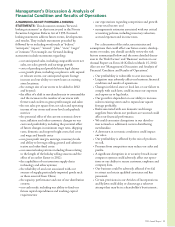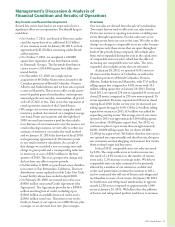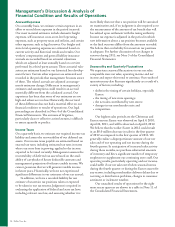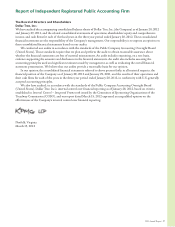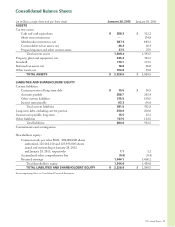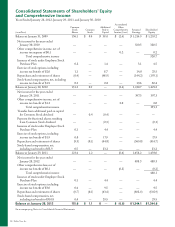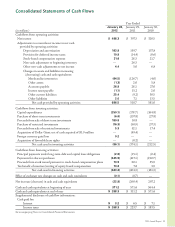Dollar Tree 2011 Annual Report Download - page 25
Download and view the complete annual report
Please find page 25 of the 2011 Dollar Tree annual report below. You can navigate through the pages in the report by either clicking on the pages listed below, or by using the keyword search tool below to find specific information within the annual report.
0DQDJHPHQW·V'LVFXVVLRQ$QDO\VLVRI
)LQDQFLDO&RQGLWLRQDQG5HVXOWVRI2SHUDWLRQV
a result of this change, we recorded a non-recurring, non-
cash charge to gross profit and a corresponding reduction
in inventory, at cost, of approximately $26.3 million in
the first quarter of 2010. e retail inventory method
is an averaging method that is widely used in the retail
industry and results in valuing inventories at lower of
cost or market when markdowns are taken as a reduction
of the retail value of inventories on a timely basis.
Inventory valuation methods require certain signifi-
cant management estimates and judgments, including
estimates of future merchandise markdowns and shrink,
which significantly affect the ending inventory valuation
at cost as well as the resulting gross margins. e aver-
aging required in applying the retail inventory method
and the estimates of shrink and markdowns could, under
certain circumstances, result in costs not being recorded
in the proper period.
We estimate our markdown reserve based on the
consideration of a variety of factors, including, but not
limited to, quantities of slow moving or seasonal, carryover
merchandise on hand, historical markdown statistics and
future merchandising plans. e accuracy of our estimates
can be affected by many factors, some of which are outside
of our control, including changes in economic conditions
and consumer buying trends. Historically, we have not
experienced significant differences in our estimated reserve
for markdowns compared with actual results.
Our accrual for shrink is based on the actual, histor-
ical shrink results of our most recent physical inventories
adjusted, if necessary, for current economic conditions
and business trends. ese estimates are compared to
actual results as physical inventory counts are taken and
reconciled to the general ledger. Our physical inven-
tory counts are generally taken between January and
September of each year; therefore, the shrink accrual
recorded at January 28, 2012 is based on estimated
shrink for most of 2011, including the fourth quarter. We
have not experienced significant fluctuations in historical
shrink rates beyond approximately 10-20 basis points in
our Dollar Tree stores for the last few years. However, we
have sometimes experienced higher than typical shrink in
acquired stores in the year following an acquisition. We
periodically adjust our shrink estimates to address these
factors as they become apparent.
Our management believes that our application of the
retail inventory method results in an inventory valuation
that reasonably approximates cost and results in carrying
inventory at the lower of cost or market each year on a
consistent basis.
Derivative Financial Instruments
In March 2008, we entered into two $75.0 million
interest rate swap agreements. ese interest rate swaps
were used to manage the risk associated with interest
rate fluctuations on a portion of our $250.0 million
variable rate term loan. Under these agreements, we paid
interest to financial institutions at a fixed rate of 2.8%. In
exchange, the financial institutions paid us at a variable
rate, which approximated the variable rate on the debt,
excluding the credit spread. ese swaps qualified for
hedge accounting treatment and expired in March 2011.
In 2011, we were party to fuel derivative contracts
with third parties which included approximately 3.5
million gallons of diesel fuel, or approximately 31% of our
domestic truckload fuel needs. ese derivative contracts
do not qualify for hedge accounting and therefore all
changes in fair value for these derivatives are included in
earnings. We currently have fuel derivative contracts to
hedge 2.8 million gallons of diesel fuel, or approximately
41% of our domestic truckload fuel needs from February
2012 through July 2012 and 0.5 million gallons of diesel
fuel, or approximately 16% of our domestic truckload fuel
needs from August 2012 through October 2012.
Critical Accounting Policies
e preparation of financial statements requires the use
of estimates. Certain of our estimates require a high level
of judgment and have the potential to have a material
effect on the financial statements if actual results vary
significantly from those estimates. Following is a discus-
sion of the estimates that we consider critical.
Inventory Valuation
As discussed in Note 1 to the Consolidated Financial
Statements, inventories at the distribution centers
are stated at the lower of cost or market with cost
determined on a weighted-average basis. Cost is assigned
to store inventories using the retail inventory method
on a weighted-average basis. Under the retail inven-
tory method, the valuation of inventories at cost and
the resulting gross margins are computed by applying
a calculated cost-to-retail ratio to the retail value of
inventories. From our inception and through fiscal 2009,
we used one inventory pool for this calculation. Because
of our investments over the years in our retail technology
systems, we were able to refine our estimate of inventory
cost under the retail method and on January 31, 2010,
the first day of fiscal 2010, we began using approximately
30 inventory pools in our retail inventory calculation. As
2011 Annual Report 23


